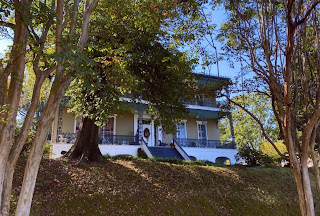Bald Eagles On The Upper Mississippi River
According to Aaron, our education presenter on the cruise, the Mississippi River valley is a major fly path for many eagles (and other birds). While they can be seen in almost all states, they are predominately in Alaska, Minnesota and Wisconsin. Here is some Upper Mississippi River eagle trivia:
- An eagle's head stays dark until age 5.
- In the early 70s, DDT nearly decimated the eagle population.
- When only one nest could be found (by boat/survey between St. Paul and St. Louis) a loud alarm was raised and finally in 1973 DDT was banned.
- Unless you are Native American, it is illegal to own any part of an American Bald Eagle.
- Eagles mate for life; they lay 1-3 eggs per year with only a 50% survival rate.
- Eaglets fledge in 8-12 weeks.
- Nests can be as big and heavy as a VW bug!
- Eagles only weigh 7-8 pounds and have a 6-8 foot wingspan. They can turn their heads 180o.
- Females are 1/3 larger than males.
- The name "bald" comes from an Old English word meaning white.
- Why is this our national bird? And not the turkey (as Benjamin Franklin lobbied for)? It was decided that an eagle symbol was more militant and a turkey was, well.... a turkey.
- They can live 18-20 years in the wild but twice that long in captivity.
- Their "eagle eyes" can spot a hopping rabbit 3 miles away.
- The Upper Mississippi River is prime habitat for Bald Eagles.... lots of trees to the shore line, lots of islands.
- Eagles eat mostly fish; their talons are as big as a man's hand.
One does not need to be a card-carrying bird watcher to appreciate our American Bald Eagle. Out on the top deck of our ship, it was fun to look for and spot eagles with other passengers. We were all appreciative.



Comments
Post a Comment